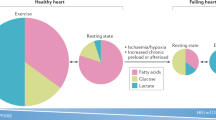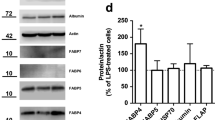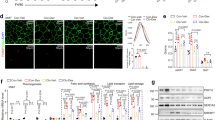Abstract
The peroxisome proliferator-activated receptor-γ (PPAR-γ) is a member of the nuclear receptor family of transcription factors, a large and diverse group of proteins that mediate ligand-dependent transcriptional activation and repression1,2. Expression of PPAR-γ is an early and pivotal event in the differentiation of adipocytes3,4,5,6. Several agents that promote differentiation of fibroblast lines into adipocytes have been shown to be PPAR-γ agonists7,8,9,10, including several prostanoids, of which 15-deoxy-Δ12,14-prostaglandin J2 is the most potent8,9, as well as members of a new class of oral antidiabetic agents, the thiazolidinediones7, and a variety of non-steroidal anti-inflammatory drugs (NSAIDs)10. Here we show that PPAR-γ agonists suppress monocyte elaboration of inflammatory cytokines at agonist concentrations similar to those found to be effective for the promotion of adipogenesis. Inhibition of cytokine production may help to explain the incremental therapeutic benefit of NSAIDs observed in the treatment of rheumatoid arthritis at plasma drug concentrations substantially higher than are required to inhibit prostaglandin G/H synthase (cyclooxygenase).
This is a preview of subscription content, access via your institution
Access options
Subscribe to this journal
Receive 51 print issues and online access
$199.00 per year
only $3.90 per issue
Buy this article
- Purchase on Springer Link
- Instant access to full article PDF
Prices may be subject to local taxes which are calculated during checkout







Similar content being viewed by others
References
Mangelsdorf, D. J. et al. The nuclear receptor superfamily: the second decade. Cell 83, 835–839 (1995).
Lemberger, T., Desvergne, B. & Wahli, W. Peroxisome proliferator-activated receptors: a nuclear receptor signaling pathway in lipid physiology. Annu. Rev. Cell Dev. Biol. 12, 335–363 (1996).
Chawla, A., Schwarz, E. J., Dimaculangan, D. D. & Lazar, M. A. Peroxisome proliferator-activated receptor (PPAR) gamma: adipose-predominant expression and induction early in adipocyte differentiation. Endocrinology 135, 798–800 (1994).
Tontonoz, P., Hu, E., Graves, R. A., Budavari, A. I. & Spiegelman, B. M. mPPAR gamma 2: tissue-specific regulator of an adipocyte enhancer. Genes Dev. 8, 1224–1234 (1994).
Tontonoz, P., Hu, E. & Spiegelman, B. M. Stimulation of adipogenesis in fibroblasts by PPAR gamma 2, a lipid-activated transcription factor. Cell 79, 1147–1156 (1994).
Hu, E., Tontonoz, P. & Spiegelman, B. M. Transdifferentiation by myoblasts by the adipogenic transcription factor PPAR gamma and C/EBP alpha. Proc. Natl Acad. Sci. USA 92, 9856–9860 (1995).
Lehmann, J. M. et al. An antidiabetic thiazolidinedione is a high affinity ligand for peroxisome proliferator-activated receptor gamma (PPAR gamma). J. Biol. Chem. 270, 12953–12956 (1995).
Kliewer, S. A. et al. Aprostaglandin J2 metabolite binds peroxisome proliferator-activated receptor gamma and promotes adipocyte differentiation. Cell 83, 813–819 (1995).
Forman, B. M. et al. 15-Deoxy-delta 12,14-porostaglandin J2 is a ligand for the adipocyte determination factor PPAR gamma. Cell 83, 803–812 (1995).
Lehmann, J. M., Lenhard, J. M., Oliver, B. B., Ringold, G. M. & Kliewer, S. A. Peroxisome proliferator-activated receptors alpha and gamma are activated by indomethacin and other non-steroidal anti-inflammatory drugs. J. Biol. Chem. 272, 3406–3410 (1997).
Hotamisligil, G. S., Shargill, N. S. & Spiegelman, B. M. Adipose expression of tumor necrosis factor-alpha: direct role in obesity-linked insulin resistance. Science 259, 87–91 (1993).
Patton, J. S. et al. Interferons and tumor necrosis factors have similar catabolic effects on 3T3 L1 cells. Proc. Natl Acad. Sci. USA 83, 8313–8317 (1986).
Torti, F. M., Torti, S. V., Larrick, J. W. & Ringold, G. M. Modulation of adipocyte differentiation by tumor necrosis factor and transforming growth factor beta. J. Cell Biol. 108, 1105–1113 (1989).
Marshall, M. K., Doerrler, W., Feingold, K. R. & Grunfeld, C. Leukemia inhibitory factor induces changes in lipid metabolism in cultured adipocytes. Endocrinology 135, 141–147 (1994).
Berg, M., Fraker, D. L. & Alexander, H. R. Characterization of differentiation factor/leukaemia inhibitory factor effect on lipoprotein lipase activity and mRNA in 3T3-L1 adipocytes. Cytokine 6, 425–432 (1994).
Lang, C. H., Dobrescu, C. & Bagby, G. J. Tumor necrosis factor impairs insulin action on peripheral glucose disposal and hepatic gluose output. Endocrinology 130, 43–52 (1992).
Szalkowski, D., White-Carrington, S., Berger, J. & Zhang, B. Antidiabetic thiazolidinediones block the inhibitory effect of tumor necrosis factor-alpha on differentiation, insulin-stimulated glucose uptake, and gene expression in 3T3-L1 cells. Endocrinology 136, 1474–1481 (1995).
Braissant, O., Foufelle, F., Scotto, C., Dauca, M. & Wahli, W. Differential expression of peroxisome proliferator-activated receptors (PPARs): tissue distribution of PPAR-alpha, -beta, and -gamma in the adult rat. Endocrinology 137, 354–366 (1996).
Greene, M. E. et al. Isolation of the human peroxisome proliferator activated receptor gamma cDNA: expression in hematopoietic cells and chromosomal mapping. Gene Express. 4, 281–299 (1995).
Devchand, P. R. et al. The PPARalpha-leukotriene B4 pathway to inflammation control. Nature 384, 39–43 (1996).
Yu, K. et al. Differential activation of peroxisome proliferator-activated receptors by eicosanoids. J. Biol. Chem. 270, 23975–23983 (1995).
Meade, E. A., Smith, W. L. & DeWitt, D. L. Differential inhibition of prostaglandin endoperoxide synthase (cyclooxygenase) isozymes by aspirin and other non-steroidal anti-inflammatory drugs. J. Biol. Chem. 268, 6610–6614 (1993).
Lau, C. S., Morley, K. D. & Belch, J. J. Effects of fish oil supplementation on non-steroidal anti-inflammatory drug requirement in patients with mild rheumatoid arthritis—a double-blind placebo controlled study. Br. J. Rheumatol. 32, 982–989 (1993).
Feldmann, M., Brennan, F. M. & Maini, R. N. Role of cytokines in rheumatoid arthritis. Annu. Rev. Immunol. 14, 397–440 (1996).
Brennan, F. M. & Feldman, M. Cytokines in autoimmunity. Curr. Opin. Immunol. 8, 872–877 (1996).
Moreland, L. W. Treatment of rheumatoid arthritis with a recombinant human tumor necrosis factor receptor (p75)-Fc fusion protein. N. Engl. J. Med. 337, 141–147 (1997).
McEvoy, G. K. (ed) AHFS 97 Drug Information (American Society of Health-Systems Pharmacists, Bethesda, MD, (1997)).
Firestein, G. S. & Zvaifler, N. J. Anticytokine therapy in rheumatoid arthritis. N. Engl. J. Med. 337, 195–197 (1997).
Acknowledgements
We thank T. Gulick for advice, guidance, time and key reagents. This work was supported by a grant from Amgen, Inc., and awards from the NIH. A.T. is a fellow of the Cancer Research Institute.
Author information
Authors and Affiliations
Corresponding author
Rights and permissions
About this article
Cite this article
Jiang, C., Ting, A. & Seed, B. PPAR-γ agonists inhibit production of monocyte inflammatory cytokines. Nature 391, 82–86 (1998). https://doi.org/10.1038/34184
Received:
Accepted:
Published:
Issue Date:
DOI: https://doi.org/10.1038/34184
This article is cited by
-
Mechanisms and functions of SUMOylation in health and disease: a review focusing on immune cells
Journal of Biomedical Science (2024)
-
Arachidonic acid-derived lipid mediators in multiple sclerosis pathogenesis: fueling or dampening disease progression?
Journal of Neuroinflammation (2024)
-
Sub-nanosized vanadate hybrid clusters maintain glucose homeostasis and restore treatment response in inflammatory disease in obese mice
Nano Research (2024)
-
Peroxisome proliferator activated receptor-gamma (PPAR-γ) ligand, pioglitazone, increases analgesic and anti-inflammatory effects of naproxen
Naunyn-Schmiedeberg's Archives of Pharmacology (2024)
-
Einfluss von PPAR-γ-Agonisten auf die kalzifizierende Degeneration kardiovaskulärer Prothesen
Zeitschrift für Herz-,Thorax- und Gefäßchirurgie (2024)
Comments
By submitting a comment you agree to abide by our Terms and Community Guidelines. If you find something abusive or that does not comply with our terms or guidelines please flag it as inappropriate.



